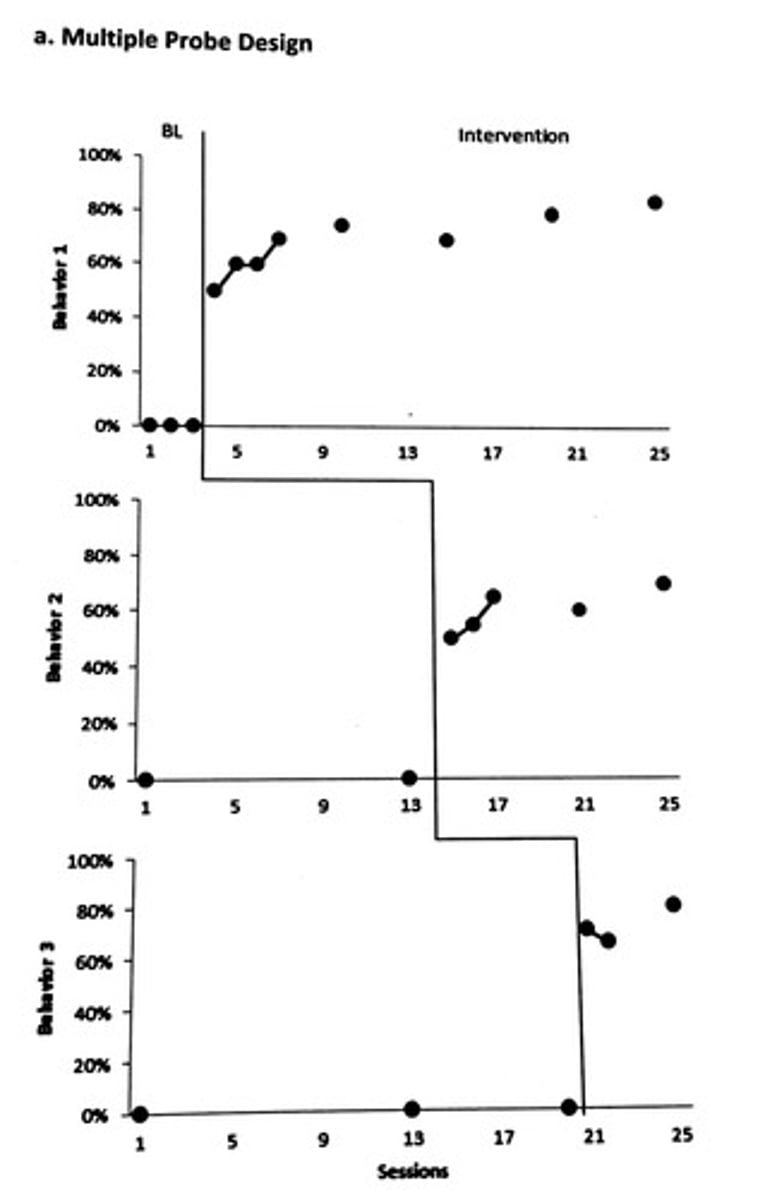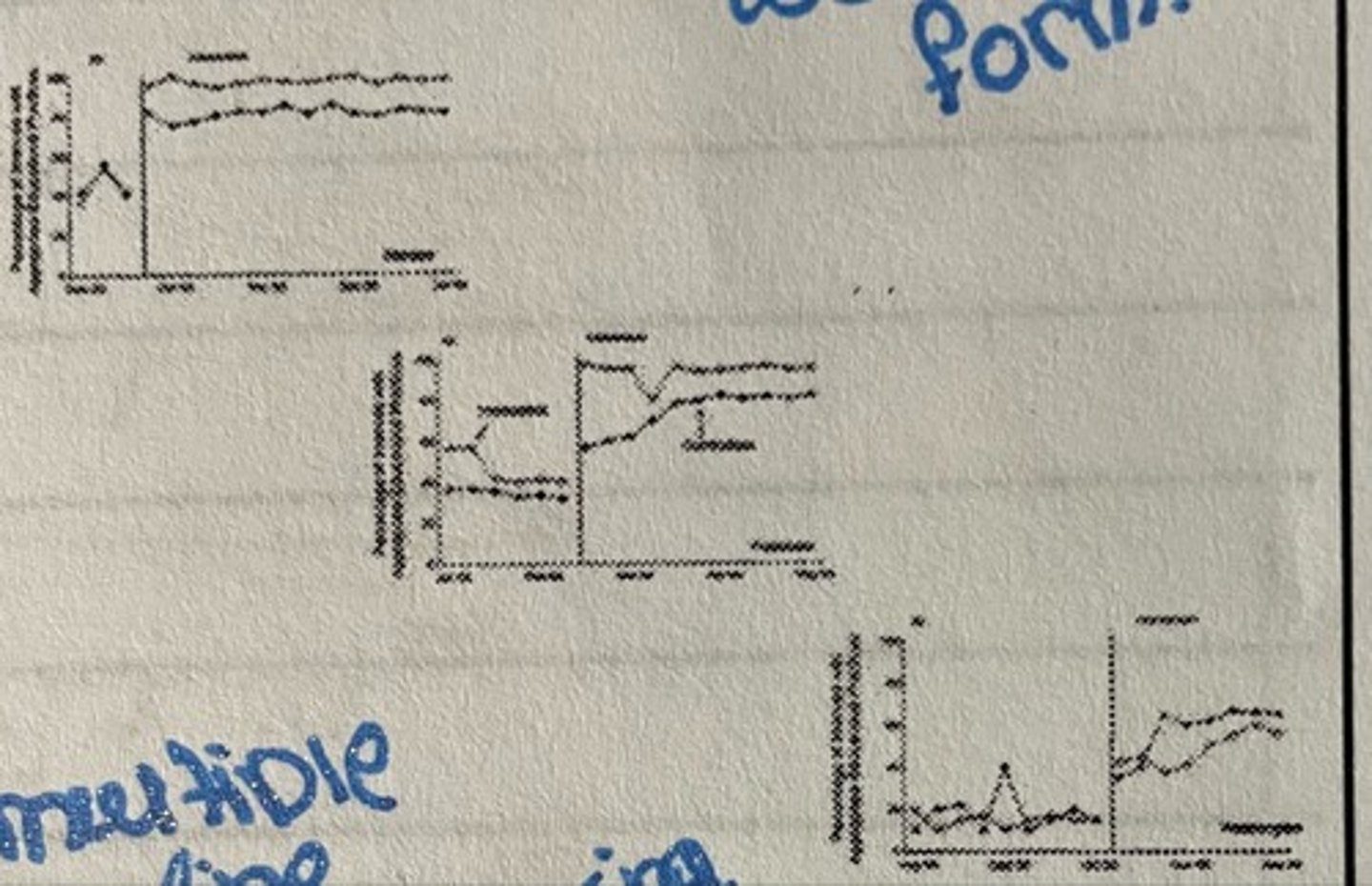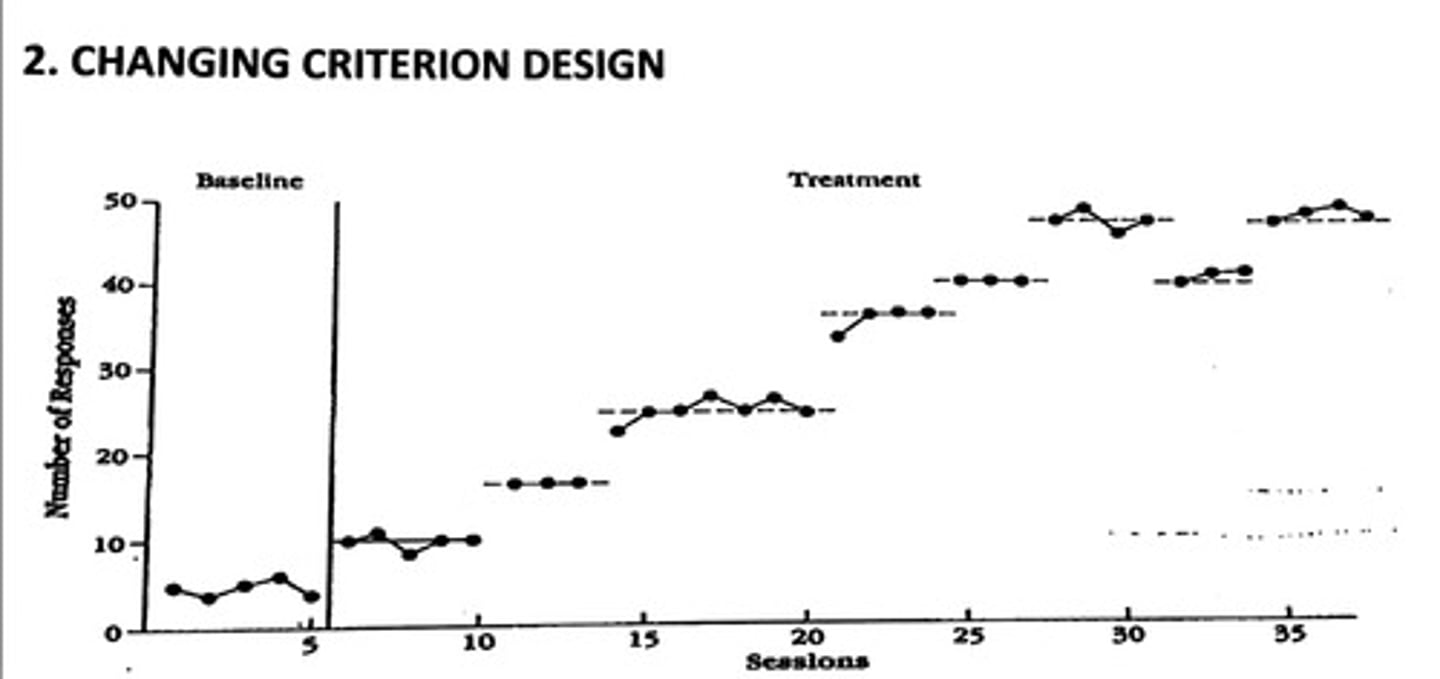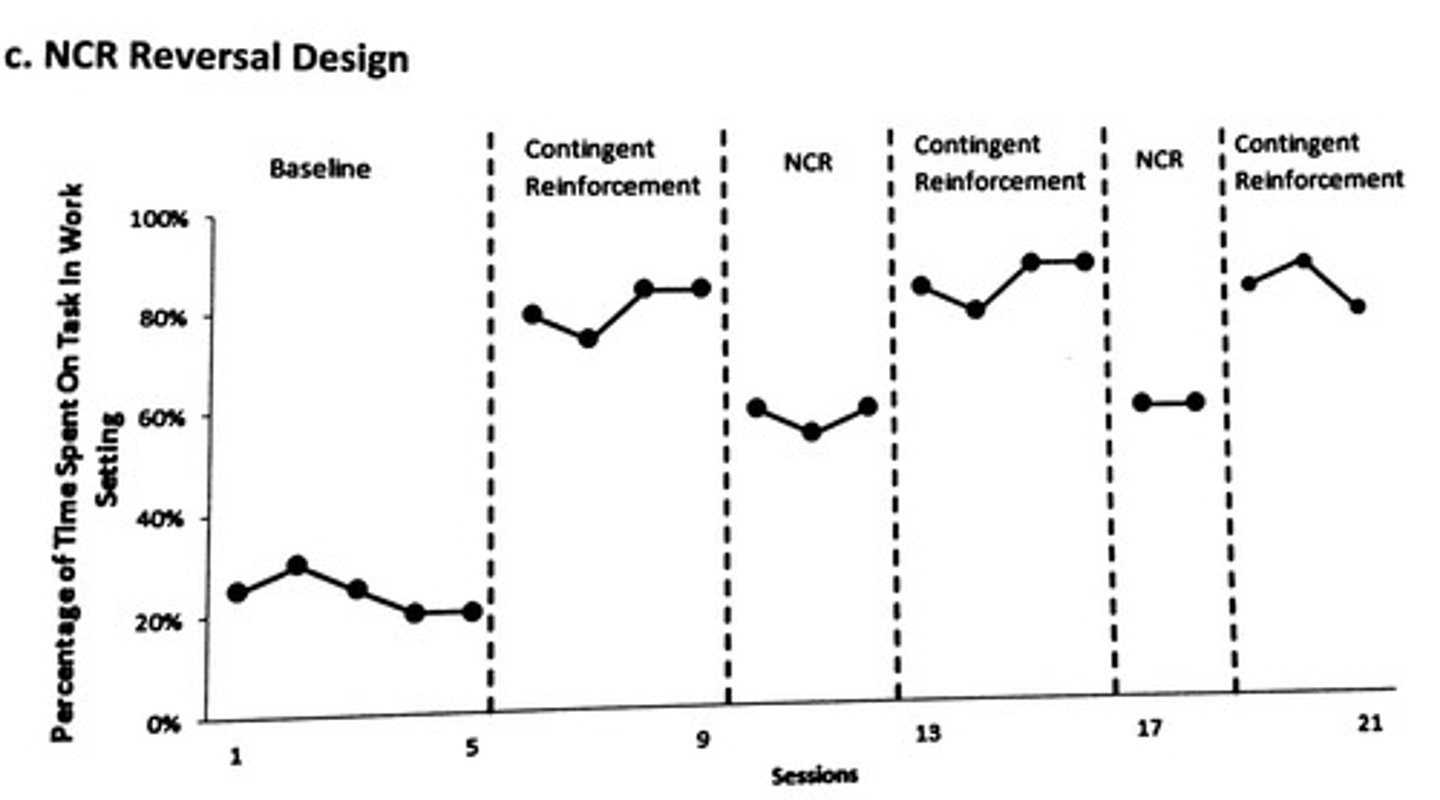Experimental Design Terms | BACB 5th Edition Section D
1/47
There's no tags or description
Looks like no tags are added yet.
Name | Mastery | Learn | Test | Matching | Spaced |
|---|
No study sessions yet.
48 Terms
Steady state responding
- a pattern of target behavior responding with minor variations over time
- establishes the foundation of baseline logic
4 patterns of baseline data
- Descending baseline
- Ascending baseline
- Variable baseline
- Stable baseline
3 parts of baseline logic
- Prediction
- Verification
- Replication
Prediction
The projected result of a presently unknown measurement to be determined in the future
Verification
When the effectiveness of the IV is proven when, with the removal of the IV, the behavior returns to baseline values --> helps to show that IV has control of the behavior
Replication
When you reintroduce the IV and the results are similar to previous outcomes in previous treatment conditions --> demonstrates reliability and believability
Multiple baseline design
- The IV is implemented in a staggered fashion across behaviors, settings, or subjects
- Shows generalization of the effects of the IV across behaviors, settings, or subjects
- Most utilized experimental design (because of flexibility and ease)
- Use when: target behaviors are irreversible; when it is not appropriate or possible to remove an effective IV; when you are looking to show generalization effects

Subtypes of the multiple baseline design
1. Multiple baseline across behaviors
2. Multiple baseline design across settings
3. Multiple baseline across subjects
Weaker variations of the multiple baseline design
1. Multiple probe design
2. Delayed multiple baseline design
3. Nonconcurrent multiple baseline design
Multiple probe design
- Staggered measurement or probes (i.e. single data points) are collected instead of systematic concurrent data in the baseline phase
- Analyzes the relation between the IV and acquisition of skill sequences in which mastery of previous steps is needed to acquire future steps of performance sequence
- Use when: you don't need concurrent/continuous measurement for a behavior or it is impractical and/or too costly
- Use for: teaching sequences (probes provide baseline prior to and after each sequence being taught); analyzing a shaping program

Delayed multiple baseline design
- Initial baseline and intervention begin and subsequent baselines are added in a delayed/staggered fashion
- Use when: reversal design isn't feasible or is seen as ineffective; your resources are limited, preventing you from a full-scale traditional multiple baseline design; a novel behavior, subject, or setting becomes available or known to you and measurement or new tiers begins with later onset data collection

Nonconcurrent multiple baseline across participants design
- Conduct a series of AB designs in a specific order across subjects at different points in time (differing the length of the baseline phase each time you conduct the AB design)
- Use when: you can't take concurrent measures across subjects

Changing criterion design
- Experimental design in which an initial baseline phase is followed by a series of treatment phases consisting of successive and gradually changing stepwise changes to criteria for which SR or punishment changes
- Rule: only 1 behavior can be targeted in this design, which must already be in the subject's repertoire

Reversal design
- Any experimental design in which responding is reversed to a level obtained in a previous condition
- 1 DV and 1 IV
- requires 3 consecutive phases; initial baseline, intervention, return to baseline

5 variations of the reversal design
1. Repeated reversal
2. BAB reversal
3. Multiple treatment design
4. Noncontingent reinforcement (NCR) reversal technique
5. DRO/DRI/DRA reversal technique
Sequence effects
Possible confounding variables when reversal designs are used to compare 2 or more IVs
Repeated reversal
When you prolong the ABAB
BAB reversal
A 3-phase reversal design (intervention/baseline/intervention)
Multiple treatment design (2 or more IVs and 1 DV)
- This reversal sub-type design compares 2 or more IVs to baseline or to each other to see which IV is most effective
- You can tell you're dealing with a multiple treatment reversal when letters are added (e.g. C, D, E etc.)
Noncontingent reinforcement (NCR) reversal technique
- This reversal sub-type design shows the effects of SR by using NCR as a control condition instead of a baseline condition in which no SR is provided
- Use for: examining the effects of NCR and contingent reinforcement
- Requires a minimum of 5 phases (e.g. ABCBC)

DRO/DRI/DRA reversal technique
- This reversal sub-type design shows the effects of SR by using DRO, DRA, or DRI as a control condition instead of a baseline condition in which no SR is provided
- Requires a minimum of 5 phases (ABCBC) A = baseline, B = SR, C = DRO/DRA control condition
- B and C conditions are repeated to identify effects on behavior
- Only design that reliably proves a functional relation (i.e. experimental control)
Multielement design ( 2 or more IVs and 1 DV)
- An experimental design in which 2 or more IVs are presented in rapidly alternating succession and the differential effects of each IV on the target behavior is measured
- Use for: comparing 2 or more IVs to each another to see which IV is best
- Steady state responding is not required in this design
SDs are often associated with each condition to help client discriminate the conditions
5 Variations of the Multielement Design
1. Single phase without initial baseline
2. 2-phase with initial baseline
3. 3-phase with initial baseline, comparison, and final best treatment phase
4. 3-phase with initial baseline, comparison, and final participant's choice
5. Concurrent chains design
Multielement design single phase without initial baseline
- most basic application of multielement design
- comparisons made in 1 phase
Multielement design 2-phase with initial baseline
- 2 phases = baseline and treatment
- need stability in baseline
Multielement design 3-phase with initial baseline, comparison and final best treatment phase AND 3-phase with initial baseline, comparison and final participant's choice
- 3 phases = baseline, treatment, and final phase for most effective treatment only or the participant's choice
Concurrent chains design
- A multielement treatments design sub-type when you have your client make a choice between = 2 (or more) concurrently available IVs
- You present IV (token system vs. a premack principle) options with and Sd for each design
3 problems avoided by multielement design
1. irreversibility
2. sequence effects
3. unstable data
Nonparametric Analysis
- A type of experiment in which you present and remove the IV to evaluate the effect of your client's DV
- (HINT) nonparametric has the word ON in it, so either the IV is ON/present or OFF/absent in this type of design
- Ex. medication is either given or not given in the course of a study
Parametric analysis
- a type of experiment in which you manipulate the value of the IV to see its effects on your client's DV
- Use for: when you want to look at the effects of the range of values of an IV on your client's DV
- Ex. A doctor provides a patient various doses of medication to see it's varying effects on the patient's stomach-ache (the DV)
Component analysis
- An experiment in which you examine each component (all the IVs) within your client's treatment package
- Use for: assessing which IVs or combination of IVs are most effective
Comparative analysis
- Compares 2 or more IVs to assess which IV is most effective
- Use for: comparing (and selecting) which IV to use
Extraneous Variable
Any aspect of the environment that must be held constant to prevent unplanned environmental variation, usually something the experimenter is aware of and for which he/she does his/best to plan
- ex. lighting, space, temperature of the room
Confounding Variable
Any uncontrolled factor known or suspected to exert influence on the dependent variable that is unexpected and not considered in planning
- ex. you passed your driver's license exam! The day before, you dad happened to get a ticket for not using his blinker. The question happened to come up on your exam the next day (random confounding variable that helped you pass)
Internal validity
The extent to which an experiment strongly shows that changes in behavior are a direct result of the IV and not the result of some other uncontrolled/unknown variables
External validity (generalizable to the external world)
Extent to which the results of a study can be generalized to other settings, behaviors, or subjects
2 main error types in research
1. Type I error (false positive) - assuming the IV effected the DV (but it actually didn't)
2. Type II error (false negative) - assuming the IV didn't impact the DV (but it did)
Of all the baseline data patterns, which is the pattern that is the clearest demonstration of the effects of the IV on the DV?
Stable
Baseline logic is known as demonstrating
functional relations
List the 4 confounding threats to internal validity
- measurement confounds
- Independent variable confounds
- Subject confounds
- Setting confounds
Reversal design
- DRO/DRA/DRI techniques
- Repeated reversals
- Multiple treatments
- NCR technique
- BAB
Multiple baseline design
- Across subjects
- Multiple probe
- Delayed multiple baseline
- Across settings
- Across behaviors
How many IVs are tested in a multiple baseline design?
1
How many IVs are tested in a multielement design?
2-4
How many DVs are tested in a multielement design?
1
How many DVs are tested in a multiple baseline design?
2-4
What is the control condition in a single subject design?
Baseline